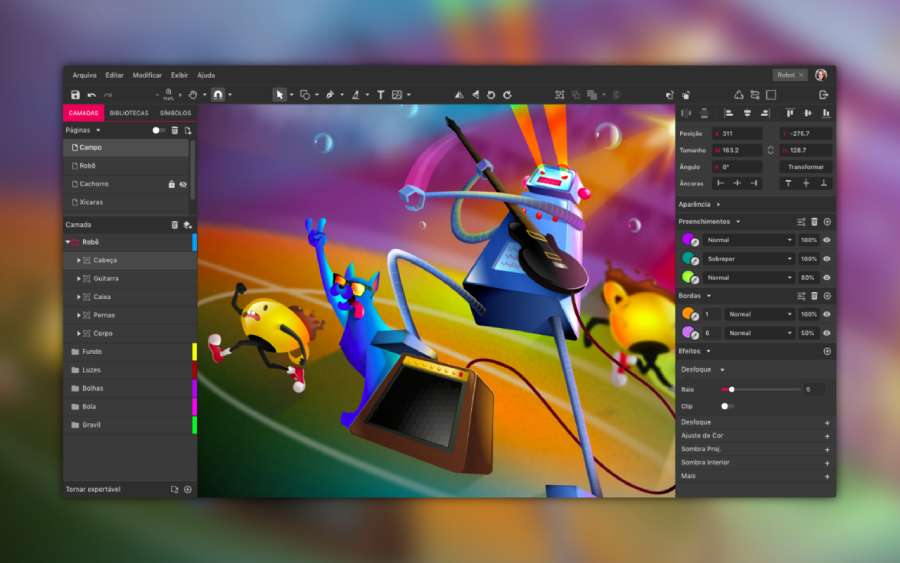Best Selling Products
Super Simple 5-Step Graphic Self-Learning Instructions for Beginners
Nội dung
- 1. Introduction to graphic design industry and career opportunities
- 1.1. Fields in graphic design industry
- 1.2. Required skills
- 2. 5-step guide to self-study graphics in super simple way
- 2.1. Step 1: Determine your goals and the design field you want to pursue
- 2.2. Step 2: Choose the appropriate graphics software and get familiar with the tool
- 2.3. Step 3: Learn the basics of graphic design
- 2.4. Step 4: Practice regularly and create real projects
- 2.5. Step 5: Build a Portfolio and Search for Career Opportunities
- 3. The Future of Graphic Design
- Conclude
With 5 super simple steps to self-study graphics at home updated in the following article will help you become a professional designer.

In today's digital age, graphic design is increasingly becoming one of the hottest fields, attracting many young people to pursue. However, not everyone has the conditions to attend professional courses at training schools. To help you learn effectively on your own, SADESIGN will share 5 super simple steps to self-study graphics, from equipping yourself with basic knowledge to practicing skills through practice.
1. Introduction to graphic design industry and career opportunities
Graphics is a creative field that has a profound impact on many different industries, from advertising, marketing, communications, to application development and web design. With the strong development of technology and the increasing demand for visual communication, career opportunities in the graphics industry are rich and diverse.
1.1. Fields in graphic design industry
- Graphic communication design : Create communication products such as flyers, posters, banners, advertisements and other printed publications.
- Web Design : Focuses on creating user interfaces (UI) and user experiences (UX) for websites and applications.
- Packaging design : Create designs for product packaging, helping the product stand out and attract consumers.
- Logo and Brand Identity Design : Building symbols and brand identity systems, helping companies and organizations build their image and brand.
- Illustration Design : Create illustrations for books, magazines, advertisements and other creative projects.
- Motion Graphics : Using moving graphic elements in video or animation, commonly used in television commercials, social media videos, and digital media products.

1.2. Required skills
- Creative skills : The ability to imagine and create new, unique ideas.
- Knowledge of color and composition : Understand how to use color, proportion, and space to create harmonious and understandable designs.
- Proficient in design software : Use tools such as Adobe Photoshop, Illustrator, InDesign, and other design software.
- Communication and teamwork skills : Graphic design is not just about creating a product, but also about working with clients and colleagues to understand requirements and come up with the best solution.
2. 5-step guide to self-study graphics in super simple way
The great thing about graphic design is that it doesn’t require you to have a high level of education or a professional degree. Instead, you can start learning right at home with easily accessible online tools and materials. Below, we will introduce 5 simple but effective steps to help you learn graphics from basic to advanced.
2.1. Step 1: Determine your goals and the design field you want to pursue
Before you start learning graphic design, the first important thing you need to do is clearly define your learning goals. The field of graphic design is very broad and can include logo design, web design, print graphic design, etc. Each of these fields requires a different set of skills and software, so defining this from the beginning will help you focus in the right direction.

Define career goals
You can ask yourself: Do you want to work with media companies or open your own design studio? Do you intend to become a freelance designer or participate in large projects, working in a team? By answering these questions, you will have a clearer view of your career path.
Select a specific design field
Once you have identified your career goals, you need to choose the field of graphic design you want to pursue. Popular options include:
- Logo and branding design : Suitable if you love building brand images for businesses.
- User Interface (UI) and User Experience (UX) Design : If you want to work in web design or app development.
- Print Graphic Design : If you love creating printed materials like flyers, posters, book covers, product packaging, etc.
2.2. Step 2: Choose the appropriate graphics software and get familiar with the tool
Once you have determined your goals and field, the next step is to choose the right software for the design work you want to do. There are many graphics tools available today, each with its own unique features suitable for each type of work. Here are some popular software that you should learn about:
Adobe Photoshop

Photoshop is a powerful graphics software, specialized for image editing, digital graphic design, and creating creative publications. This is an indispensable tool for those working in the field of graphic design.
Adobe Illustrator
If you want to design logos, icons, or vector graphics, Adobe Illustrator is the ideal choice. This software supports the creation of vector drawings that are easily editable without losing image quality when enlarged.
CorelDRAW
This is a popular vector graphics design software, especially in the printing industry. CorelDRAW has an easy-to-use interface and supports many powerful features for graphic design.
Affinity Designer
If you don't want to invest in Adobe but still want professional software, Affinity Designer is a good choice. It has powerful features and costs much less than Adobe.
Procreate (For iPad)
For those who love to draw and design on their tablets, Procreate is a great tool for graphic designers and creative artists.
2.3. Step 3: Learn the basics of graphic design

Whether you're self-studying or taking an online course, you'll need to equip yourself with basic knowledge of graphic design, including:
Concept of color and color scheme
Color is an important part of any graphic design. You need to understand the principles of color coordination, how to choose colors that match the message and emotions you want to convey.
Typography
Typography is an essential element of graphic design. You need to learn how to choose the right fonts for your design and make them easy to read and work well with your layout.
Layout and proportions
Layout is the arrangement of graphic elements in a design space. Learning how to balance elements like images, text, and white space will help you create professional designs.
Basic design principles
Understanding principles like balance, contrast, rhythm, and unity will help you create effective and engaging designs.
2.4. Step 4: Practice regularly and create real projects

One of the most important factors in becoming a good designer is practice. You need to spend time practicing, experimenting with tools and software to improve your skills.
Practice with small projects
Start with simple projects, like designing a logo for a friend, making a poster for a small event, or creating images for blog posts. These projects will help you improve your skills quickly and can be used to build your portfolio later.
Find inspiration
Refer to outstanding designs from other designers, find inspiration on platforms like Behance, Dribbble, Pinterest to learn and gain experience for yourself.
Work on feedback
Getting feedback from people more experienced than you will help you identify the strengths and weaknesses of your designs. This will help you improve quickly.
2.5. Step 5: Build a Portfolio and Search for Career Opportunities

Once you have accumulated a large enough body of work, create a portfolio to present to clients or employers. Your portfolio is the most important tool to help you score points with people looking for designers.
Create an online portfolio
You can build a portfolio on platforms like Behance, Dribbble, or create your own website. Your portfolio should include projects you’ve done, a brief description of each project, and the skills you used.
Join the designer community
Joining graphic design groups on social media or online forums will help you connect with others in the industry, get feedback, and find career opportunities.
3. The Future of Graphic Design

With the rapid development of technology, the graphic design industry has more and more opportunities to develop, especially in the field of digital design. Today's graphic designers need to be able to adapt to new technology trends such as artificial intelligence, virtual reality (VR), augmented reality (AR), and motion design.
The graphic design industry not only offers many career opportunities in creative, advertising, and media companies, but also opens up opportunities to work freelance or start your own company.
Conclude
Self-studying graphic design at home is a challenging but also very simple journey for those who are interested in learning, studying and updating knowledge. If you follow the 5 steps of self-studying graphic design that SADESIGN shared in the article - from determining learning goals, choosing the right software, learning basic knowledge, practicing through practice, to building a portfolio and finding career opportunities - you can completely become a professional designer. The most important thing is that you need to be patient, passionate and always keep learning to improve your skills and meet the requirements in the graphic design industry. Wish you success!












































